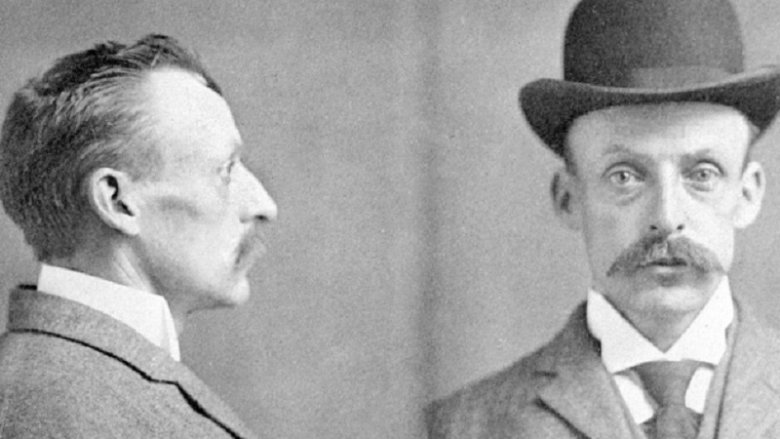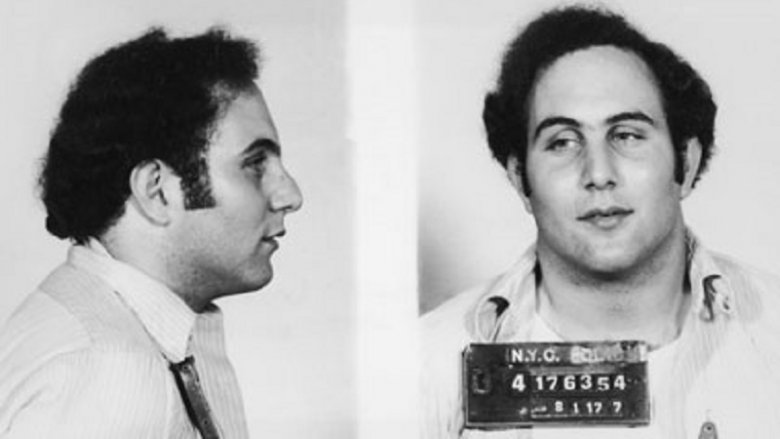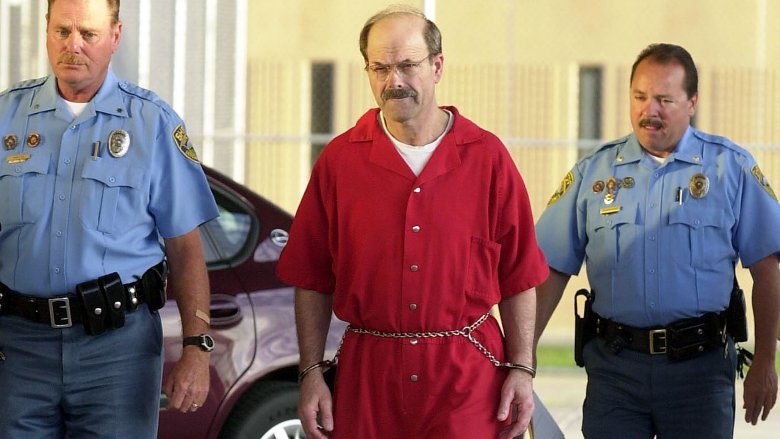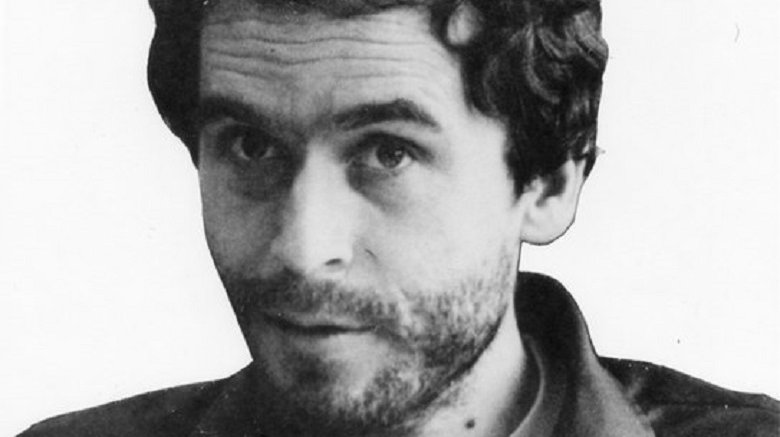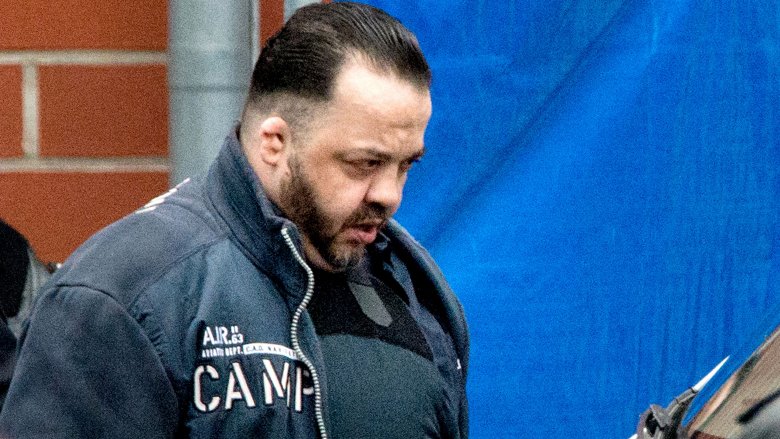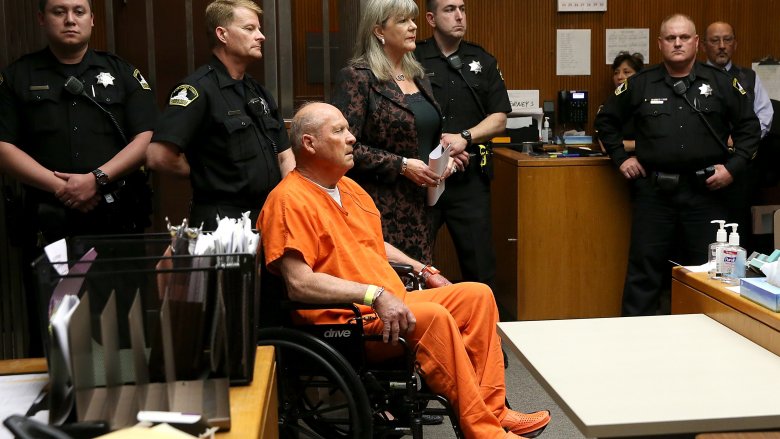How These Notorious Serial Killers Were Really Caught
Parents often tell their kids monsters don't exist, but just listen to a true crime podcast or watch an episode of Mindhunters and it becomes pretty clear the world is full of bloodthirsty beasts in the form of serial killers. These real-life monsters prey on the weak and enjoy hurting others, but unlike the cinematic slashers of Halloween or A Nightmare on Elm Street, you can actually stop a serial killer. Sure, they're violent psychopaths who seem larger-than-life, but despite their twisted minds and demonic deeds, they're only human. Sooner or later, they're bound to slip up. Some bring their own downfall by taunting the cops, others get sloppy as they get older, and some are defeated by the almighty power of technology. From terrifying tales of old-timey cannibals to modern-day murderers straight from the headlines, these are the stories about notorious serial killers and how they were finally caught.
Stationery stops the Grey Man
Albert Fish was a real-life bogeyman. Thin, old, and mustachioed, he was known as "The Grey Man," and with a nickname like that, it should come as no surprise that Fish was literally an eater of children. Fish killed and dismembered at least three kids, with his most notorious victim being 10-year-old Grace Budd. After ingratiating himself into the Budd family as "Frank Howard," Fish offered to take the little girl to a birthday party, only this celebration involved more strangling and cannibalism than ice cream and cake.
After killing Grace Budd, Fish decided to taunt her family, writing a horrific letter explaining how much he enjoyed feasting on her flesh. But Fish's need to brag is what brought him down. Detective William King noticed a unique seal on the envelope sent to the Budd family — a hexagonal symbol belonging to the New York Private Chauffeur's Benevolent Association — and traced it back to a janitor who'd swiped some of the association's stationery. However, when the janitor moved out of his rooming house, he'd left the stationery behind, so all King needed to do was discover who was living there now.
So the detective staked out the rooming house, and eventually, the Grey Man appeared. When King confronted him, Fish pulled a razor and tried slicing the detective, but killing a kid and killing a cop are two different things. He was no match for the officer, who wrestled him to the ground. After a ten-day trial, the Grey Man wound up in the electric chair for history's biggest Fish fry.
The key to catching Jeffrey Dahmer
Jeffrey Dahmer was no ordinary serial killer. He collected skulls, practiced necrophilia and cannibalism, and tried turning victims into zombie slaves. Before getting caught, Dahmer murdered 17 people and turned his apartment into a shrine of death, full of bones and preserved body parts.
Dahmer would trick unsuspecting men into his apartment, where things got really nasty really fast. And while there were a few hiccups here are there, his plan was pretty much foolproof — until he picked up Tracy Edwards. Dahmer offered him $100 to pose for racy photos, but once he got his victim inside, Dahmer slapped handcuffs on Edwards and pulled out a gigantic knife. He then forced Edwards into his bedroom where they began the strangest movie night ever, with Dahmer watching The Exorcist III while chanting and rocking back and forth.
While Dahmer was distracted, Edwards bashed him over the head and escaped his lair. He quickly found some cops, showed them the cuffs, and asked for help. Together, the two officers and Edwards went to Dahmer's apartment where the killer said he'd step into his bedroom and fetch the key. But when Edwards mentioned Dahmer's knife was back there, one of the cops decided he'd search the room himself, and that's when he spotted a stash of brutal photos of body parts and dismembered corpses.
Realizing the Polaroids were real, the cop shouted for his partner to grab Dahmer. The serial killer tried fighting back but to no avail. After cuffing him, the cops found an apartment full of genitals, refrigerated heads, and an altar made of skulls. It was the grisliest decorating job in American history, and Tracy Edwards was the key to tearing it all down.
A dog walker defeats the Son of Sam
From 1976 to 1977, New Yorkers lived in a state of panic. There was a serial killer stalking the street, blasting down victims with a .44-caliber pistol. Worse still, this mysterious murderer was leaving behind letters, mocking the police and calling himself the "Son of Sam." As the cops tried and failed to catch the killer, the city lived in terror, with six victims falling to the Son of Sam's bullets. But it all ended one night in 1977, when an eagle-eyed woman named Cacilia Davis took her dog for a walk.
Davis was strolling through Brooklyn, when a strange looking man stormed by. He was holding his right arm in a strange way, almost like he was hiding something in his sleeve, and Davis remembered the guy staring straight at her. Minutes later, gunshots rang out, leaving Stacy Moskowitz mortally wounded and Robert Violante partially blinded. When Davis learned about the murder, she realized she'd been in the same vicinity as the shooting, and that's when she remembered the oddball barreling down the street.
Convinced this was the Son of Sam, Davis called the police with a hot tip, and she also recalled seeing an officer in the area ticketing an illegally parked sedan. After looking into the ticket, the cops discovered the vehicle belonged to one David Berkowitz, who lived over 20 miles away from the murder scene. Thanks to Davis' tip, the authorities focused their investigation on Berkowitz who eventually confessed to the crime, which shows that sometimes you should seriously pay attention to the weird vibes you feel from people.
BTK gets busted by a floppy disc
Dennis Rader was known as "BTK," a sick acronym that stands for "Bind Torture Kill." Over 17 years, Rader murdered ten victims, including almost every member of the Otero family in 1974. Like his moniker suggests, Rader was a sadist who got a sexual thrill from hurting people. In addition to his psychopathic perversions, Rader was incredibly cocky. In 2004, 30 years after the Otero murders, Rader was craving the spotlight. He'd always been the kind of killer who taunted the cops, and now he started it up again, sending documents to local news stations, letting everyone know BTK was alive and well.
But as the old saying goes, pride comes before the fall. That's especially true when you don't know the first thing about technology. See, Rader wanted to send all his letters on floppy discs, but he was unsure if the cops could track him down through the tech. So he literally asked the police if it was possible, telling them to respond through the classifieds and, most importantly, to "be honest." Obviously, the cops had no intention of telling the truth, and when Rader mailed his floppy disc, it was all downhill from there for the serial killer.
After opening a document, authorities went to the properties section, and saw it had been saved by a "Dennis" and recently used at a nearby church. So when they learned that a Dennis Rader was a respected member of this particular church's congregation, they ran a DNA test. When it came back positive, BTK was bound for life, but what bothered Rader the most was that the cops had lied to him. He was genuinely hurt by their trickery, but he had no one to blame but himself for using that floppy disc ... and also for murdering ten people.
Ted Bundy was an escape artist
One of the most notorious serial killers who's ever lived, Ted Bundy was captured three times before being locked up for good. It all started in August 1975, when a Utah cop noticed Bundy sitting in a Volkswagen outside somebody's home. It was 3 a.m., and there was something off about Bundy's behavior, especially when he fled the scene. After the officer pulled Bundy over, he discovered a rape kit in the car, so he hauled the monster into jail. But Bundy's stint in the Utah slammer was pretty short, as he was released on bond, free to kill again.
Bundy would end up behind bars once more after he was found guilty of attempted kidnapping. But as he was being moved from one facility to another, Bundy jumped from a second-story window when nobody was watching. His great escape didn't last long, as he was picked up shortly afterward in Aspen, Colorado. However, things took a bloody turn in 1977, when Bundy realized he could saw through the bars in the ceiling of his Colorado cell. The man lost over 30 pounds, and once he'd cut through the metal, he was able to shimmy his way to freedom.
Before he could be recaptured, Bundy would kill three more people and leave a trail of destruction behind him at Florida State University's Chi Omega sorority house. But Bundy's reign of terror came to a halt when Officer David Lee of Pensacola spotted Bundy driving a stolen vehicle. Lee didn't know Bundy was a serial killer, but when the guy kicked his legs out from under him, Lee pulled his gun and fired two shots at the fleeing Bundy. When that didn't work, he chased Bundy down, and after a brutal wrestling match, Bundy ended up in cuffs. Once he was hauled into jail by the Pensacola police, Bundy's killing days were finally at an end.
Niels Högel is caught then kills
Germany has had its fair share of murderers, but it's been decades and decades since the country has seen a killer like Niels Högel. In fact, Högel makes guys like Ted Bundy, John Wayne Gacy, and Jeffrey Dahmer look like amateurs. Between 1999 and 2005, Högel worked as a nurse at two hospitals, and death seemed to follow him wherever he went. At the Delmenhorst hospital, the ICU death rates actually doubled, probably because Högel got his kicks by poisoning people and trying to resuscitate them. It allegedly gave him an incredible high to save a patient — a patient he had put in danger — but more often than not, Högel was better at slaughtering than saving.
Using a deadly combo of drugs, Högel allegedly killed at least 100 people, all so he could feel good and impress his colleagues. But the madman was finally caught in 2005 when a member of the hospital staff walked in and saw Högel doing the deed. However, even though Högel was reported for trying to murder a patient, the head honchos at the hospital waited two whole days before contacting the authorities, and during that time, Högel killed again. Sure, he was busted, but thanks to incompetence and neglect for over six years (several other hospital employees are facing negligent manslaughter charges), Högel's nursing turned a place of healing into a living hell.
Genetics gets the Golden State Killer (probably)
Most famous serial killers end up behind bars, but there are a few who've escaped the long arm of the law. There's the Zodiac Killer and Jack the Ripper, and for a while, it looked like the Golden State Killer had joined their bloodthirsty ranks. Also known as the East Area Rapist, this serial killer was responsible for 13 murders and at least 50 rapes across California. The dude was as evil as they come, even calling up his old rape victims and threatening to murder them. But nobody could catch the guy. In fact, authorities didn't even realize the Golden State Killer and the East Area Rapist were the same guy until 2001.
However, when the Golden State Killer was busy raping and killing back in the '70s and '80s, he had no idea some futuristic invention called the internet would eventually bring him down. Flash forward to the 21st century, and California authorities decided to run some of the killer's DNA against profiles on a genealogy website called GEDmatch. And that's when they found a partial match — someone related to the Golden State Killer. From there, it was only a matter of time before the police ended up on the doorstep of Joseph James DeAngelo, a 72-year-old ex-cop whose DNA was an exact match for the man who'd terrorized California for so long. At time of writing, DeAngelo is awaiting trial and is, of course, innocent until proven guilty.
Dennis Nilsen is flushed out of hiding
Dennis Nilsen was basically the British Jeffrey Dahmer — a gay serial killer who lured men to his apartment to strangle them and have his way with the corpses. However, since Nilsen lived in a North London apartment, body disposal posed a bit of a problem, especially since he killed up to 15 people in just a few years. Nilsen kept stashing the corpses under the floorboards until there was no room left. When the smell (and the flies) got too awful, he had a great big bonfire in the backyard, and nobody thought to ask what he was burning.
However, Nilsen's predicament got even more complicated when he moved to an attic flat that didn't have floorboards to use as a cemetery. So he decided to try the "dead goldfish" trick: dismembering the bodies and flushing them down his toilet. This technique worked for a while, until someone else in the apartment building called a plumber because their drains were all clogged up. When the plumber investigated, he discovered the pipes were full of flesh. He decided to return the next day for a more in-depth inspection, but Nilsen worked through the night to clear out the pipes.
Of course, that only made the plumber incredibly suspicious when he returned. That's when the cops got involved, and they eventually wound up at Nilsen's flat. The serial killer still had body parts in his bedroom, and the stench was awful. So when the cops got a whiff, Nilsen didn't even resist. He immediately admitted there was bodies bagged up in the back, and just like that, Nilsen was flushed out of hiding by his own stupid scheme.
A mob and a little boy bring down the Night Stalker
Richard Ramirez had a lot of creepy names. He was known as "The Walk-In Killer," "The Valley Intruder," and "The Screen Door Intruder." But the name that really stuck was "The Night Stalker." From 1984 to 1985, the Night Stalker would break into homes across Los Angeles and murder everyone in sight, sometimes strangling, sometimes stabbing, sometimes shooting. The man killed everyone from little girls to elderly men, and he would often rape his victims, burglarize their homes, and he even forced one woman to pledge her love to Satan.
But Ramirez's reign of terror came to a halt thanks to 13-year-old James Romero. One dark evening, the boy saw the Night Stalker in his backyard. Realizing he'd been spotted, Ramirez drove off in an orange Toyota, which the boy described to police. A few days later, the cops found the abandoned station wagon and lifted a fingerprint. Ramirez's file was already in the system thanks to an earlier theft, so the cops found his photo and plastered it all over California.
However, Ramirez didn't realize his identity had been discovered. He was off in Arizona when the story broke, and he wasn't paying attention to the news. So when he returned to L.A. and popped inside a store, he was shocked to see his face in the newspaper. He freaked out and tried escaping by stealing a car, but like many people, the people of East L.A. don't take kindly to carjackers. Angry neighbors chased Ramirez down the street, and once they caught him, they beat him to a bloody pulp, only realizing they'd captured a serial killer after the cops arrived. After getting chased down by an entire neighborhood, Ramirez spent the rest of his life behind bars, all thanks to a 13-year-old kid and a bunch of angry Angelenos.
Andrei Chikatilo's clothes sell him out
The Soviet Union had a problem. According to the state, the USSR was a utopian society where serial killers couldn't exist. However, between 1978 and 1990, one of those nonexistent serial killers was wreaking havoc across Russia. Known as "The Rostov Ripper," Andrei Chikatilo was an absolute savage, killing at least 50 people in the most brutal ways possible. He would lurk around train stations and bus stops and then lure his victims, both young males and females, into the woods where things would get really messed up.
The state's denial of serial killers made things difficult for Soviet police to catch this creep, but they did their best to keep an eye on Chikatilo's stomping grounds. Eventually, that paid off when a watchful policeman noticed Chikatilo at a train station, looking a tad conspicuous. His clothes were covered in leaves and mud like he'd been doing something in the woods, and he had an odd amount of blood on his earlobe and cheek, plus a hand injury. Even though he couldn't prove Chikatilo had done anything wrong, the cop had a feeling this squirrely-looking guy was up to no good.
Concerned, the officer filed a report, and when a body later showed up in the area, the cops looked through records to see if anybody weird had been stopped near the crime scene. They stumbled across Chikatilo's record and discovered he'd been questioned in regards to multiple murders connected to the Rostov Ripper. Intrigued, they watched Chikatilo for six days, and after witnessing him harass a lot of young women and kids, they hauled him into the station where he cracked under some Soviet-style interrogation.

